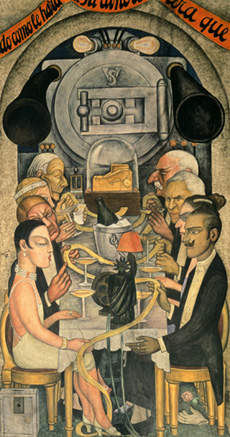So, on both sides of the system there is copious spending in order to hold power in government. What if you would be a good President but don't have $44 million stuffed under the mattress for use in the next campaign? I'm not bashing candidates that spend a lot on their campaigning; if they have the money then they can do whatever they want. It's simply difficult to not notice that running for office cost an unbelievably large amount of money, and that this could very well discriminate against a large amount of U.S. citizens interested in running for office. And it's not just running for President. One website says, "Sometimes people make rought estimates about how much a campaign will cost. Usually, the suggestion is $1 to $2 per household in your district." The number of households in any given district depends, but even if it is a reasonably small district, that's still millions of dollars we're discussing here.
If you've kept with me for this long, thank you, but you're probably wondering about how all of this relates to my post's title, "Warren Buffett and Diego Rivera, how do they Relate?" Warren Buffett is a man of tremendous fortune, most know this. But did you know that Buffett attended a $35,800 per person fundraiser in Winnetka for President Obama last year? (link to source) These topics have come up in my American Studies class, yet still relate to topics discussed in my Spanish class.
 In Spanish, we learned about Mexican artists during an art history unit. Of these artists, we studied muralists of the early 20th century in particular, and of them was Diego Rivera. Rivera was a fervent believer in Communism and he shared these ideals throughout his artwork in many ways. His murals were often very large, sometimes spanning entire rooms. In one of these such rooms were two smaller murals, one called "Our Bread" (on the left) and one called "Wall Street Banquet" (on the right). It is not difficult to see the similarities in how the murals are formatted; in both we see people eating at a table from the same vantage point. If you pay attention to some of the details in each piece, however, you may notice some Communism vs. Capitalism themes. One can argue that Rivera is promoting Communism in the piece on the left by showing family values and religious themes, thus suggesting Communism is as righteous as both family and religion to Rivera. You can also argue Rivera is criticizing Capitalism on the right-hand piece due to the people's semi-closed eyes (closed to the strife of the poor), lavish dining, and hoarding of money/freedom (they are eating with gold ticker tape, a vault, and the Statue of Liberty). Do you agree with any parts of what Rivera seems to be conveying through his artwork? Do you think there is a problem with our system in that it favors the rich or do you think the benefits of our system outweigh any negatives? Why or why not?
In Spanish, we learned about Mexican artists during an art history unit. Of these artists, we studied muralists of the early 20th century in particular, and of them was Diego Rivera. Rivera was a fervent believer in Communism and he shared these ideals throughout his artwork in many ways. His murals were often very large, sometimes spanning entire rooms. In one of these such rooms were two smaller murals, one called "Our Bread" (on the left) and one called "Wall Street Banquet" (on the right). It is not difficult to see the similarities in how the murals are formatted; in both we see people eating at a table from the same vantage point. If you pay attention to some of the details in each piece, however, you may notice some Communism vs. Capitalism themes. One can argue that Rivera is promoting Communism in the piece on the left by showing family values and religious themes, thus suggesting Communism is as righteous as both family and religion to Rivera. You can also argue Rivera is criticizing Capitalism on the right-hand piece due to the people's semi-closed eyes (closed to the strife of the poor), lavish dining, and hoarding of money/freedom (they are eating with gold ticker tape, a vault, and the Statue of Liberty). Do you agree with any parts of what Rivera seems to be conveying through his artwork? Do you think there is a problem with our system in that it favors the rich or do you think the benefits of our system outweigh any negatives? Why or why not?

No comments:
Post a Comment